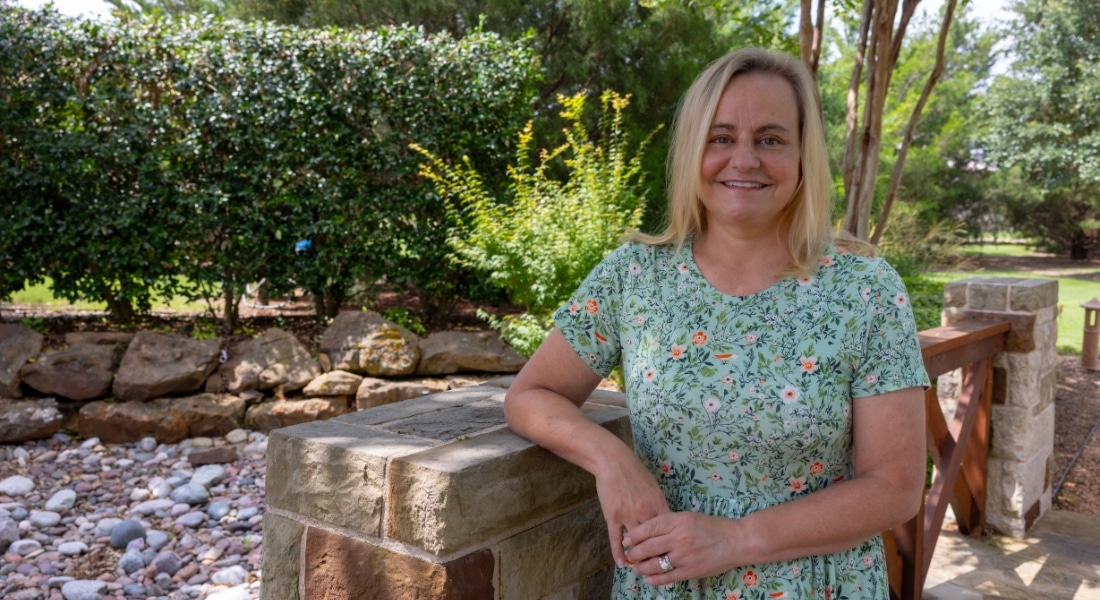Joy and gratitude have always defined the holidays for Rebecca and Jeff Landreth, but last Christmas was not very merry after a health crisis led Rebecca to the ER at Methodist Richardson Medical Center.
The gratitude, however, remained after surgeons there uncovered not one, but two life-threatening holes in her digestive tract, and she spent 51 days in the hospital fighting for her life.
“The team of Methodist doctors saved my life, more than once,” says the 55-year-old, who’s long suffered from acid reflux and IBS-C, irritable bowel syndrome with constipation.
Through it all, Rebecca’s care team became like family, and one nurse still texts to check in with her and Jeff.
“When you’re in the hospital that long, people stop being just doctors or nurses,” Jeff says. “They become part of your fight. We’re so thankful.”
Rebecca’s ordeal began in early December 2024 after she suffered complications from a previous surgery at an out-of-state hospital, her doctors say. An incision from the earlier procedure — a laparoscopic fundoplication used to correct GERD — never fully healed and split open.
She had also had trouble getting medication for her IBS-C, and her pain reached a breaking point a day after Christmas at the couple’s Parker home.
“I screamed for Jeff,” she recalls. “The pain was so intense I could barely move.”
Jeff rushed upstairs and found his wife collapsed on the bathroom floor in agony. Within minutes, Rebecca was in an ambulance on the way to Methodist Richardson.
“She was in such bad shape that she was barely alive,” Jeff says.

EMERGENCY SURGERY
Rebecca was quickly stabilized and admitted for testing. A CT scan revealed air in her abdomen, which doctors suspected was caused by holes in her colon and at the top of her stomach, a serious medical emergency.
“When a hole forms in this part of the gastrointestinal tract, it can cause stool and other intestinal fluids to leak into your abdomen, creating a life-threatening situation,” explains Stuart Johnston, MD, trauma surgeon on the medical staff at Methodist Richardson. “Emergency surgery was her only choice.”
When Dr. Johnston and his team opened Rebecca’s abdomen, they found that her colon had perforated. They also discovered a hole in her stomach near the esophagus.
“The surgeon told me that she was so constipated that her stool had turned into rocks,” Jeff says. “One of them poked through the side of her colon, and it just spilled the contents into the lower part of her body.”
Doctors cleaned out her abdomen and removed a small portion of her colon. But repairing the tear in her upper stomach proved more complicated.
“Leaking stomach fluid makes the tissue around the tear like wet paper, which prevents us from being able to stitch it closed in this condition,” Dr. Johnston says.
Trust your gut to advanced GI care at Methodist by finding a digestive health specialist near you. Visit MethodistHealthSystem.org
LESS INVASIVE OPTION
The surgery saved Rebecca’s life, but the road to recovery was far from over. The stomach tear would take months to heal, and she needed a colostomy bag in the meantime. The idea was overwhelming for someone who travels for work and finds peace in her garden.
“I couldn’t eat or drink. Not even ice chips,” says Rebecca, a business consultant. “It felt like my life had just stopped.”
Rebecca was told she might have to live on total parenteral nutrition, or TPN, receiving all food and fluids through an IV, for up to a year. Just when it seemed like TPN might be her only option, Rebecca’s care team brought in a specialist with a different idea.
Abdul El Chafic, MD, medical director of advanced endoscopy at Methodist Richardson, was determined to try a less invasive approach.
“The best endoscopic option to close holes in the GI tract is by endoscopic suturing, an innovative procedure performed by gastroenterologists with extra training in complex endoscopic procedures,” explains Dr. El Chafic. “However, the endoscopic suturing device is stiff, and it was possible I might not be able to reach the hole in this case due to its difficult location.”
In the first attempt, the stiff endoscopic suturing device could not make the sharp angle to close the perforation, so Dr. El Chafic placed a stent to slow the leak. It helped but didn’t fully solve the problem.

FINDING A WAY
Not willing to give up, Dr. El Chafic contacted the device manufacturer and learned about a more flexible endoscopic suturing device that had recently received FDA approval. With help from two engineers who flew in with the prototype, he made a second attempt.
“The second endoscopic attempt was a success using the new device,” Dr. El Chafic says. “That victory meant Rebecca would be able to eat and drink normally again much sooner. It was truly a collaborative effort by multiple physicians and surgeons to both save her life and restore her health.”
Jeff and Rebecca were both grateful that Dr. El Chafic was so determined to preserve not just her health but her quality of life, as well.
“Dr. El Chafic stayed with it, did the research, and came up with a solution,” Jeff says. “That was such a godsend.”
Now, Rebecca is walking more than 10,000 steps a day. She will undergo surgery to remove the colostomy bag and has returned to her beloved garden.
“My hibiscus are blooming,” she says, smiling. “We even had a duck lay an egg by our pool that hatched. Life is happening again. And I don’t take a single second of it for granted.”






